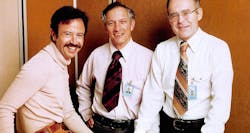If ‘only the paranoid survive,’ what does it take to thrive?
“Sooner or later, something fundamental in your business world will change.” The late Andrew Grove (1936-2016), Co-founder of tech giant Intel Corp., lived by these words. Grove, of course, would have known better than just about anyone, having thrived for decades in the cutthroat world of tech in Silicon Valley.
Grove, who along with Gordon Moore (of Moore’s Law fame) and Robert Noyce (nicknamed “The Mayor of Silicon Valley” for his business prowess) co-founded Intel in 1968, believed strongly in the value of paranoia. He was constantly on the lookout for what he called “strategic inflection points”—those moments of elemental change in a business environment that, if ignored, could mark the beginning of a downward spiral for a company or organization. It could be a technological advancement, a new competitor, a trade agreement, a tariff—anything that could lead to full-scale changes in the way business is conducted.
AEC firms, and their clients, are scrambling to keep up in this era of rapid technological and business change. They’re in a race to innovate.
In his seminal 1996 business leadership book, Only the Paranoid Survive: How to Exploit the Crisis Points That Challenge Every Company and Career, Grove called these fundamental changes “deadly when unattended to,” and believed that companies could never fully recover from a downward slide. Hence his paranoia.
But Grove also acknowledged the incredible opportunities offered to the players who were adept at navigating a changing business ecosystem. As an example, he pointed to the flood of low-cost memory chip products from Japan in the 1980s. This inflection point was so overwhelming for Intel, it forced the company—which, at that time, was nearly a billion-dollar enterprise—completely out of the memory production business and into the fledging field of microprocessors. Can you imagine walking away from an established market worth hundreds of millions of dollars in favor of the unknown?
In many respects, Grove’s state of paranoia has permeated the AEC market, and for good reason. Technological advancements—BIM/VDC, computational design, virtual reality, reality capture—are changing the way firms perform work. Startups like Airbnb and WeWork are turning their clients’ business models upside down. Economic and policy shifts are placing intense pressure on major real estate sectors, including healthcare (Affordable Care Act) and higher education (student loan crisis). And the lagging affects of the Great Recession continue to place budget stresses on building segments.
AEC firms, and their clients, are scrambling to keep up in this era of rapid technological and business change. They’re in a race to innovate.
This state of mind was evident during an AEC technology panel discussion I participated in a few months ago. One of the panelists, a digital design leader at a major architecture giant, wowed the audience with a laundry list of jaw-dropping tech innovations the firm was either using regularly, piloting, or researching—game engines, beacons, computational design, drones mounted with 3D laser scanners, to name a few.
What struck me most was what he said next. He admitted that almost on a daily basis he has deep anxiety about his firm not doing enough to stay ahead. It is something that keeps him—and his colleagues—up at night. I thought to myself, Wow, if this guy feels this way, I can’t imagine what the tech laggards are feeling?
To thrive in today’s turbulent market, AEC professionals must think and act like those early Silicon Valley pioneers: maintain a level of paranoia and be ready and willing to pivot on a dime when a strategic inflection point hits.

